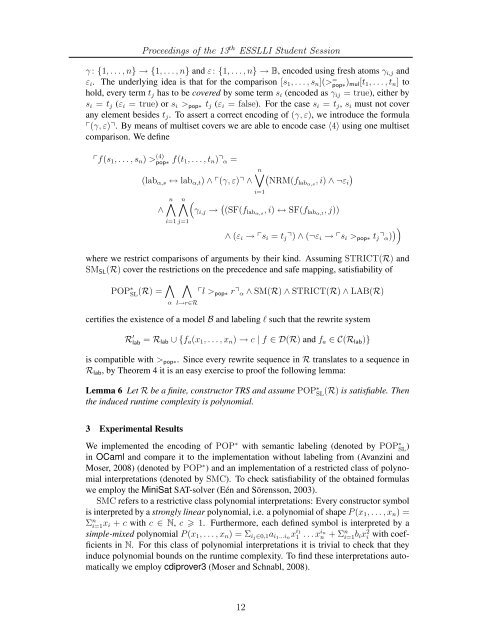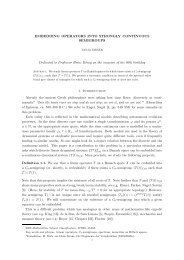Proceedings of the 13 ESSLLI Student Session - Multiple Choices ...
Proceedings of the 13 ESSLLI Student Session - Multiple Choices ...
Proceedings of the 13 ESSLLI Student Session - Multiple Choices ...
Create successful ePaper yourself
Turn your PDF publications into a flip-book with our unique Google optimized e-Paper software.
γ : {1, . . . , n} → {1, . . . , n} and ε: {1, . . . , n} → B, encoded using fresh atoms γi,j and<br />
εi. The underlying idea is that for <strong>the</strong> comparison [s1, . . . , sn](> = pop∗)mul[t1, . . . , tn] to<br />
hold, every term tj has to be covered by some term si (encoded as γij = true), ei<strong>the</strong>r by<br />
si = tj (εi = true) or si >pop∗ tj (εi = false). For <strong>the</strong> case si = tj, si must not cover<br />
any element besides tj. To assert a correct encoding <strong>of</strong> (γ, ε), we introduce <strong>the</strong> formula<br />
�(γ, ε)�. By means <strong>of</strong> multiset covers we are able to encode case 〈4〉 using one multiset<br />
comparison. We define<br />
�f(s1, . . . , sn) > (4)<br />
pop∗ f(t1, . . . , tn)�α =<br />
(labα,s ↔ labα,t) ∧ �(γ, ε)� ∧<br />
∧<br />
n�<br />
i=1 j=1<br />
n� � �<br />
NRM(flabα,s, i) ∧ ¬εi<br />
i=1<br />
n� �<br />
γi,j → � (SF(flabα,s, i) ↔ SF(flabα,t, j))<br />
∧ (εi → �si = tj�) ∧ (¬εi → �si >pop∗ tj�α) ��<br />
where we restrict comparisons <strong>of</strong> arguments by <strong>the</strong>ir kind. Assuming STRICT(R) and<br />
SMSL(R) cover <strong>the</strong> restrictions on <strong>the</strong> precedence and safe mapping, satisfiability <strong>of</strong><br />
POP ∗ SL(R) = � �<br />
�l >pop∗ r�α ∧ SM(R) ∧ STRICT(R) ∧ LAB(R)<br />
α<br />
l→r∈R<br />
certifies <strong>the</strong> existence <strong>of</strong> a model B and labeling ℓ such that <strong>the</strong> rewrite system<br />
R ′ lab = Rlab ∪ {fa(x1, . . . , xn) → c | f ∈ D(R) and fa ∈ C(Rlab)}<br />
is compatible with >pop∗. Since every rewrite sequence in R translates to a sequence in<br />
Rlab, by Theorem 4 it is an easy exercise to pro<strong>of</strong> <strong>the</strong> following lemma:<br />
Lemma 6 Let R be a finite, constructor TRS and assume POP∗ SL (R) is satisfiable. Then<br />
<strong>the</strong> induced runtime complexity is polynomial.<br />
3 Experimental Results<br />
<strong>Proceedings</strong> <strong>of</strong> <strong>the</strong> <strong>13</strong> th <strong>ESSLLI</strong> <strong>Student</strong> <strong>Session</strong><br />
We implemented <strong>the</strong> encoding <strong>of</strong> POP ∗ with semantic labeling (denoted by POP ∗ SL )<br />
in OCaml and compare it to <strong>the</strong> implementation without labeling from (Avanzini and<br />
Moser, 2008) (denoted by POP ∗ ) and an implementation <strong>of</strong> a restricted class <strong>of</strong> polynomial<br />
interpretations (denoted by SMC). To check satisfiability <strong>of</strong> <strong>the</strong> obtained formulas<br />
we employ <strong>the</strong> MiniSat SAT-solver (Eén and Sörensson, 2003).<br />
SMC refers to a restrictive class polynomial interpretations: Every constructor symbol<br />
is interpreted by a strongly linear polynomial, i.e. a polynomial <strong>of</strong> shape P (x1, . . . , xn) =<br />
Σ n i=1xi + c with c ∈ N, c � 1. Fur<strong>the</strong>rmore, each defined symbol is interpreted by a<br />
simple-mixed polynomial P (x1, . . . , xn) = Σij∈0,1ai1...inx i1<br />
1 . . . x in<br />
n + Σ n i=1bix 2 i with coefficients<br />
in N. For this class <strong>of</strong> polynomial interpretations it is trivial to check that <strong>the</strong>y<br />
induce polynomial bounds on <strong>the</strong> runtime complexity. To find <strong>the</strong>se interpretations automatically<br />
we employ cdiprover3 (Moser and Schnabl, 2008).<br />
12

















